Unusual Foods in Iran | Weirdly Wonderful Dishes
Iran is famous for its high-quality, flavorful, and diverse cuisine. From fragrant main courses to decadent desserts, refreshing salads, satisfying street snacks, and even fruits, Iranian food offers a constant stream of surprises for your taste buds.
By "unusual Iranian foods," we don't mean dishes that are unhygienic, creepy, or difficult to eat. Instead, we want to highlight some popular and common Iranian dishes that might seem strange or unexpected at first glance. You might think, "There's no way this could taste good!" or "This sounds like a taboo for my taste buds." But trust us, after your first bite, you'll be wondering why you haven't tried these dishes sooner!
Get ready to be amazed! Sit back, relax, and prepare to embark on a delicious journey through the world of unusual Iranian food. We assure you, there's not a single dish on this list you'll want to skip!
Top 12 Unusual Foods in Iran
- Tahdig
- Ashpal Kuku
- Havij Bastani
- Kahoo Sekanjebin
- Khoresht-e-Mast
- Ab-Doogh Khiar
- Delo Gholve
- Sirabi
- Kalle Pache
- Doogh & Gooshfil
- Haleem
- Gharegurut
1- Tahdig
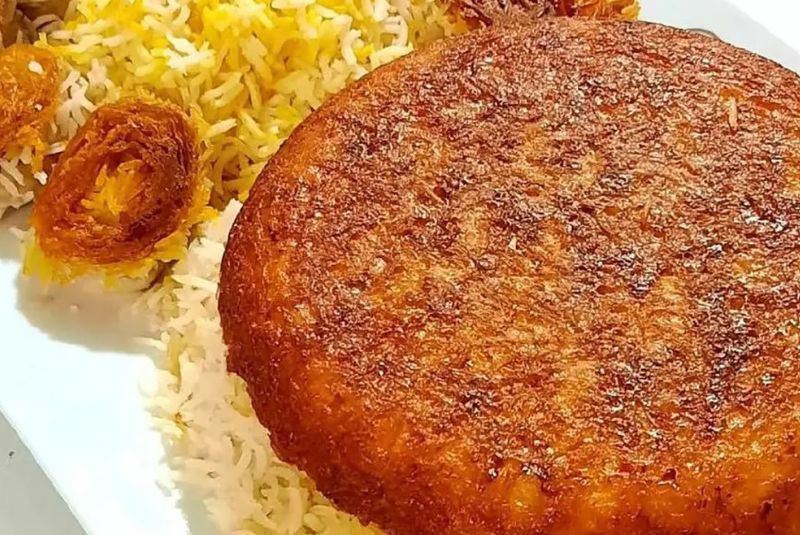
Tahdig (pronounced tah-dig) might appear like your average rice dish at first glance. But in Iranian cuisine, this seemingly simple combination of fluffy rice and a golden-crisp crust is a true art form. The magic lies in the technique: rice is steamed to perfection before being layered with oil or butter in a pot. As it cooks further, the bottom layer transforms into a delectable, deeply flavored, and most importantly, incredibly crispy crown. This prized Tahdig is the star of the show, often considered the dish's most coveted element. In fact, a skilled Iranian cook's talent is frequently measured by their ability to create the perfect Tahdig – a testament to its importance and deliciousness. So don't be surprised if you find yourself vying for that last piece of crispy perfection!
Most Tahdigs are Zaferanooni (Saffroned) and bursting with flavor. Iranian ingenuity extends even to pasta, with a unique Tahdig featuring crispy noodles and potato chips. When enjoying iconic Iranian stews like Gheyme or Ghormeh Sabzi, remember to pair them with a little bit of Khoresht (the stew itself) alongside your Tahdig. Trust us, that combination will have you feeling like the world has stopped spinning – in the best way possible!
| Related: Iranian Rice Food - Chelow
2- Ashpel Kuku
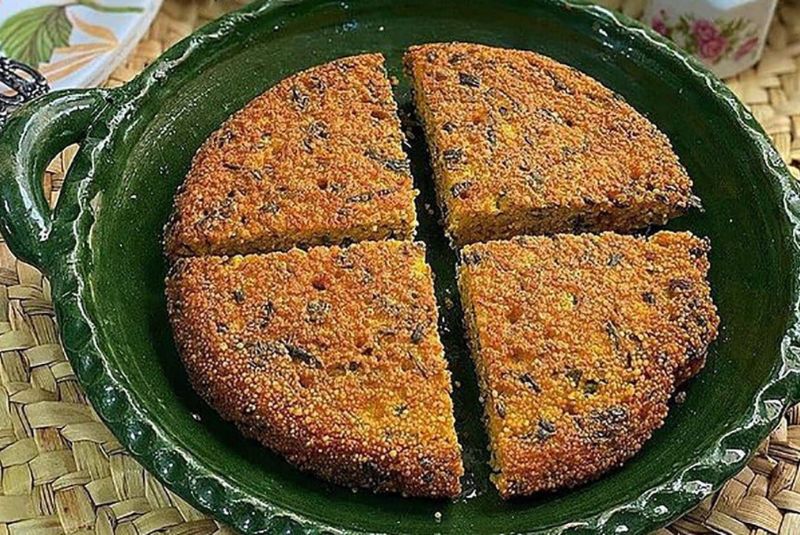
Venture beyond the usual and explore Ashpal Kuku, an authentic dish from Iran's Caspian province of Gilan. This unique creation features Ashpal, also known as fish roe, which is prized for its delicate flavor and versatility. In Ashpal Kuku, these fish eggs are combined with a symphony of spices, fragrant garlic leaves, and eggs to create a delightful custard-like dish.
Roe, or Ashpal as it's called locally, is a prized ingredient in the Caspian provinces of Gilan and Mazandaran. Traditionally, Ashpal is prepared in various ways – grilled, cured, salted, or mixed with other ingredients. Ashpal Kuku specifically showcases fresh Ashpal, whisked with eggs and other flavorful components, then pan-fried to achieve a delectable custard consistency.
While caviar may be the most well-known roe variety, Ashpal Kuku highlights the deliciousness of other fish roe like Kutum (Caspian whitefish), Caspian roach, bream, and even Caspian salmon. So, if you're looking for an exciting and flavorful adventure beyond the ordinary, Ashpal Kuku is a must-try!
| Related: Top 17 Iranian Seafood Cuisine
3- Havij Bastani
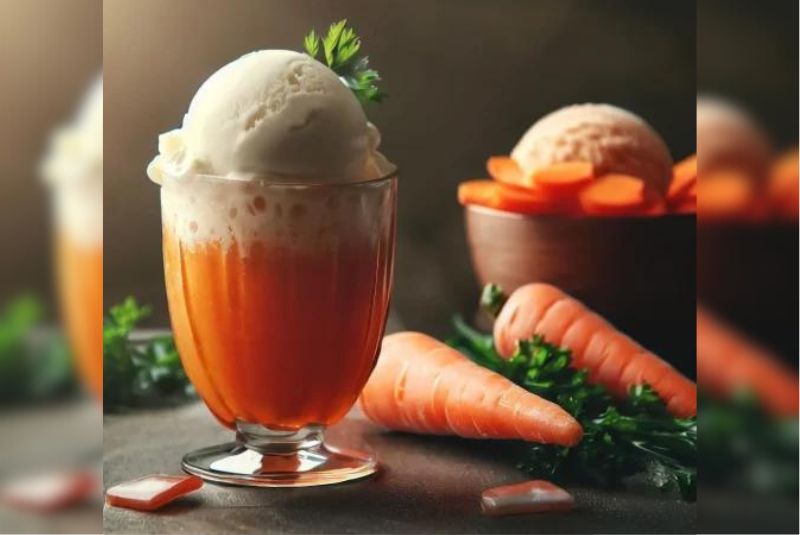
For a truly unique and refreshing experience, look no further than Havij Bastani – Iran's delightful take on the classic ice cream float. This unexpected Iranian dessert combines fresh carrot juice with a scoop of ice cream, creating a surprisingly harmonious blend.
Havij Bastani offers the best of both worlds: the creamy sweetness of ice cream (vanilla or the traditional saffron-infused version) and the cool refreshment of carrot juice. This versatile treat can be enjoyed as a beverage or a dessert, allowing you to sip it slowly or savor it with a spoon.
Havij Bastani is a feast for the senses, not just the taste buds. It's typically served in a glass, allowing the vibrant orange color of the carrot juice to shine through. The dish is often finished with a sprinkle of crushed pistachios, adding a delightful textural contrast, and sometimes a touch of cardamom or cinnamon for an extra layer of aroma.
So next time you're craving a cool treat in Iran, skip the ordinary and embrace the delightful surprise of Havij Bastani!
4- Kahoo Sekanjabin

Prepare to be surprised by Kahoo Sekanjabin, a unique Iranian snack that perfectly embodies the taste of summer. This delightful combination features Sekanjabin, a traditional syrup made with vinegar, honey, and fresh mint.
The name "Sekanjabin" is an Arabized version of the original Persian term "serkangabin," which literally translates to "honeyed vinegar." True to its name, this syrup is made with vinegar and honey, creating a sweet-and-sour base. Sekanjabin itself is a historical beverage, enjoyed for centuries in Iran. Often prepared by grandmothers, it's a staple for hot summer days. The syrup is made by simmering sugar, water, and vinegar with fresh mint, resulting in a refreshing concoction infused with a delightful mint aroma.
While Sekanjabin is traditionally enjoyed as a diluted beverage, Kahoo Sekanjabin takes it a step further. Here, the syrup is served undiluted, transforming it into a delicious dip. The star player? Crisp romaine lettuce leaves, which are dipped into the minty, sweet-and-sour sekanjabin for a delightful and unexpected flavor explosion.
This unique combination of crunchy lettuce and the refreshing sekanjabin is not only delicious but also healthy. It's a perfect light snack for a hot day, offering a delightful balance of sweet, sour, and minty flavors. So next time you're looking for a refreshing and unusual summer treat, be sure to try Kahoo Sekanjabin!
| Discover: Most Common Farsi Phrases for Tourists in Iran
5- Khoresht-e-Mast
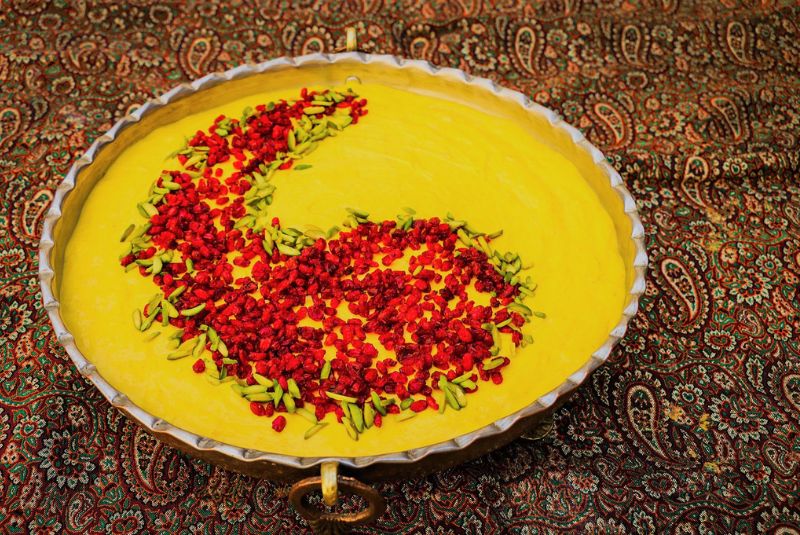
Don't let the name fool you! Khoresht-e-Mast, literally translating to "yogurt stew," is a unique and delightful dessert hailing from the historic city of Isfahan in Iran. This dish defies expectations, showcasing a surprising yet delightful combination of sweet and savory flavors.
While Khoresht typically refers to savory stews in Iranian cuisine, Khoresht-e-Mast takes a sweet turn. Traditionally reserved for feasts, it was once a luxurious dessert enjoyed by royalty. Today, it's enjoyed as a side dish or even an appetizer.
This unusual dessert features a base of yogurt, sugar, rosewater, and saffron, creating a vibrant yellow concoction with a hint of floral aroma. Shredded, braised lamb neck adds a surprising savory element, while crushed nuts like pistachios or walnuts provide a delightful textural contrast. Finally, a tangy crown of barberries finishes the dish, offering a burst of sweet and tartness in every bite.
Khoresht-e-Mast is a must-try for anyone seeking a unique and unforgettable dessert experience in Iran!
| Read more: Persian Tea - A Warm and Flavorful Journey
6- Ab-Doogh Khiar

Escape the summer heat with Ab-Doogh Khiar, a refreshing and vibrant cold soup from Iran. This delightful dish is as easy to make as it is delicious to enjoy.
Ab-Doogh Khiar translates to "water, yogurt drink, cucumber," perfectly capturing the essence of this simple yet flavorful soup. Plain yogurt, chopped cucumber, and Doogh (a chilled yogurt drink) form the base, offering a cool and creamy foundation.
Beyond the base ingredients, Ab-Doogh Khiar comes alive with additional elements. Walnuts add a delightful crunch, while fresh herbs like mint or dill provide a touch of aromatic freshness. A touch of sweetness, often from raisins, creates a harmonious balance in every spoonful.
More than just a delicious soup, Ab-Doogh Khiar is a summer staple in Iran. This cold soup offers a light and refreshing alternative to heavier meals during hot weather. Yogurt and cucumber, both considered to have "cold natures" in Iranian tradition, are believed to help cool the body down, making Ab-Doogh Khiar an ideal choice to combat the summer heat.
Enjoy Ab-Doogh Khiar as an appetizer, a light lunch, or even a refreshing dinner. This delightful soup is a true testament to the power of simple ingredients and bold flavors.
| Discover: Traditional Persian Breakfast You Should Try
7- Delo Gholve
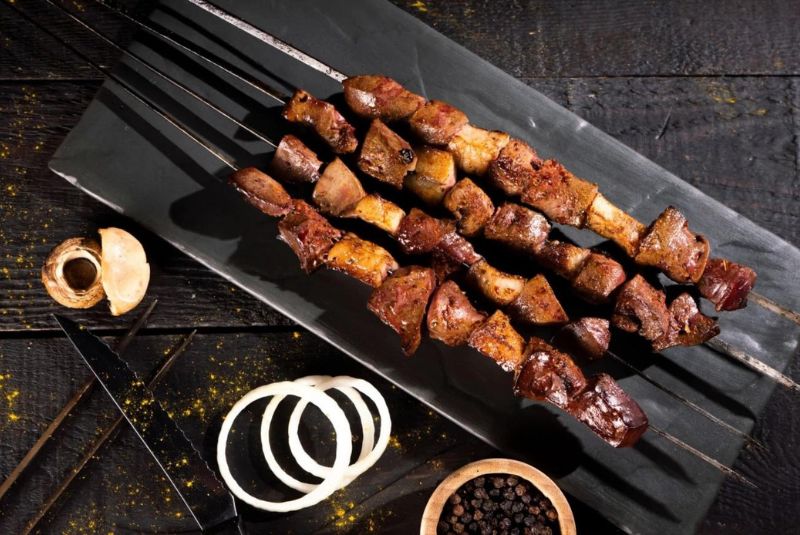
For the adventurous foodie, Delo Gholve offers a unique and delicious kebab experience in Iran. This dish might surprise you at first glance, featuring skewers of grilled sheep's heart, liver, and kidney.
While kebabs are a cornerstone of Iranian cuisine, Delo Gholve takes a bold step beyond the typical cuts of meat. These offal kebabs might seem unusual, but the enticing aroma of grilled liver wafting from the charcoal grill is enough to pique anyone's curiosity.
Don't be deterred by the ingredients! The magic happens on the grill, where these organ meats transform into a surprisingly delectable dish. The grilling process not only cooks them perfectly, but also releases a wonderful aroma that will have you reaching for a bite.
Delo Gholve is all about showcasing the natural flavors of the ingredients. A simple squeeze of lime juice, a sprinkle of salt, and a touch of fresh basil create a perfect flavor balance. This delightful kebab is often enjoyed with warm Iranian bread (Lavash or Sangak) and a cool glass of doogh, creating a truly satisfying experience.
Look for Delo Gholve on the vibrant streets of downtown Tehran, tucked away in local restaurants within traditional bazaars, or even on roadside eateries.
Delo Gholve is a reminder that stepping outside your comfort zone can lead to unexpected culinary delights. Who knows? This unique kebab experience might just become a life-changing moment for your taste buds!
| Related: Top 23 Iranian Kebab
8- Sirabi
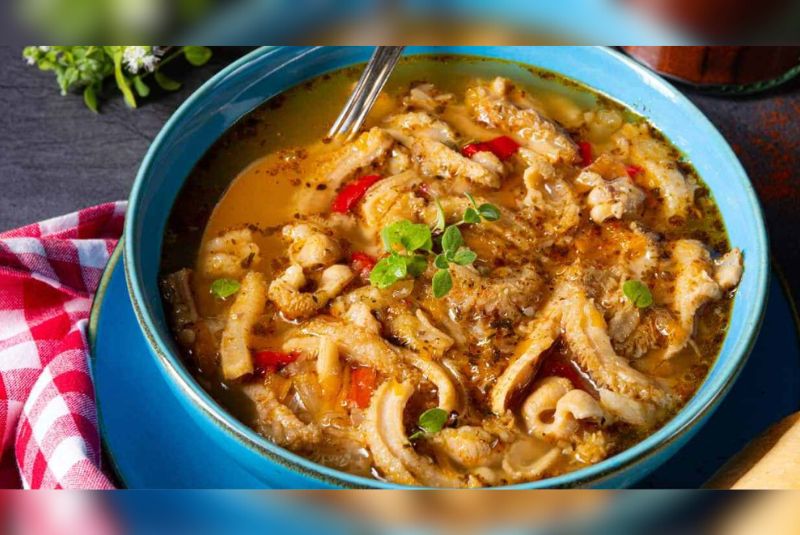
Sirabi offers a unique and flavorful journey for the adventurous eater. This traditional Iranian dish features lamb's tripe – the stomach lining of a lamb – prepared in two distinct ways: a hearty soup and a stuffed delicacy.
Sirabi requires dedication to prepare. The tripe undergoes a meticulous cleaning process and a lengthy simmering time (at least 12 hours) to ensure it becomes tender and delectable. While tripe soup might be found in various cultures, Iranian Sirabi is distinguished by its unique cooking methods and aromatic spices.
Sirabi soup is a comforting and flavorful dish. The tripe is simmered with onions, garlic, and a touch of saffron, creating a fragrant broth bursting with warmth. Chickpeas are often added for extra texture and heartiness.
For the truly adventurous, stuffed Sirabi offers an exciting exploration of textures and flavors. Cleaned tripe is transformed into a vessel, filled with a savory blend of rice, minced meat, split peas, and fragrant herbs like tarragon. Simmered in a sweet and sour sauce, this dish is a true testament to Iranian culinary ingenuity.
Sirabi might not be for everyone, but it holds a special place in Iranian cuisine. It's a dish that requires an open mind and a willingness to try something new. So, if you're looking for a unique and unforgettable culinary adventure, be sure to give Sirabi a try!
| Suggestion: Abgoosht & Dizi - Traditional Persian Stew Recipe
9- Kalle Pache

The most unusual Iranian food, Kalle Pache, is a dish that pushes boundaries and celebrates the full potential of an animal. This traditional Iranian breakfast soup features sheep's head and trotters, simmered for hours until melt-in-your-mouth tender.
While Kalle Pache might seem unusual at first glance, many cultures around the world enjoy various parts of the sheep beyond the familiar cuts. Sweetbreads (thymus), kidneys, and even brains are all enjoyed in different culinary traditions.
What sets Kalle Pache apart is its focus on utilizing often-overlooked parts and transforming them into a delicious and healthy dish. The long and meticulous cooking process is key here. It not only tenderizes the meat but also extracts all the hidden flavors and nutrients from the head and trotters.
The resulting broth is rich in collagen, believed to have numerous health benefits. The addition of aromatics like lemon and cinnamon creates a surprisingly complex and delightful flavor profile that goes beyond the initial impression of the ingredients.
Kalle Pache is not just about taste; it's a full sensory experience. The dish is often served with accompaniments like bread and herbs, allowing you to create a customized flavor adventure in every bite.
Kalle Pache is not for everyone, but for the adventurous eater, it offers a unique experience. So, if you're looking to challenge your palate, be sure to give Kalle Pache a try!
| Read more: Iranian Vegetarian Dishes
10- Doogh & Gooshfil
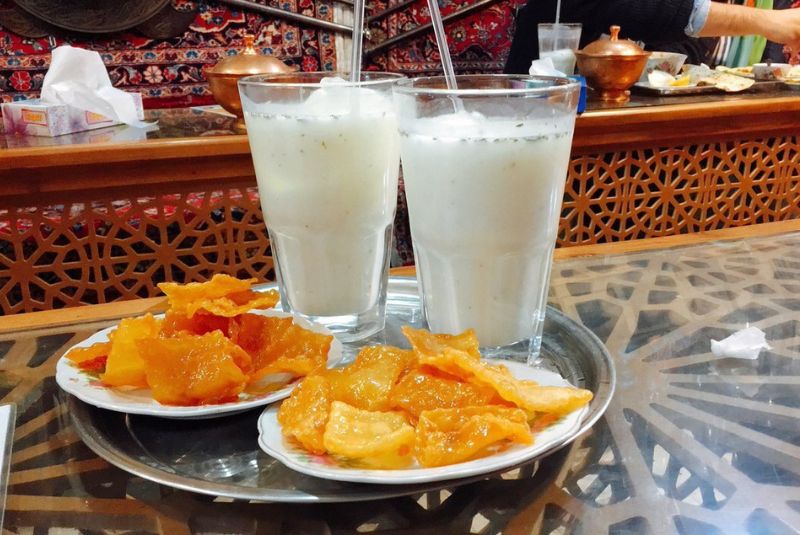
Isfahan, a city steeped in history and vibrant culture, offers a unique culinary experience that goes beyond the expected. Here, a delightful paradox awaits you: the sweet and savory pairing of Doogh and Gooshfil.
Imagine a hot summer day in Isfahan. You take a sip of Doogh, a chilled yogurt-based drink infused with the earthy aroma of dried mint and a touch of salt. This refreshing beverage is not just a thirst quencher; it's a cultural cornerstone, traditionally enjoyed alongside kebabs.
Now, comes the surprise. Alongside your Doogh sits Gooshfil, a delicate pastry literally translating to "elephant's ear" due to its shape. This flaky, golden treat is made with a base of flour, yogurt, and rosewater, and drenched in a fragrant syrup. The first bite offers a burst of sweetness, a delightful counterpoint to the savory Doogh.
The initial shock of combining sweet and savory might surprise you, but this is the magic of Isfahan's Doogh & Gooshfil. With each alternating bite, a delightful dance on your palate unfolds. The coolness of Doogh cuts through the sweetness of Gooshfil, while the pastry's sugary notes enhance the savory depth of the yogurt drink.
Whether you're exploring the bustling Naghsh-e Jahan Square or relaxing in a traditional teahouse, you'll find this delightful combination on menus. So, on your next visit to Isfahan, be sure to embrace the unexpected culinary adventure with Doogh & Gooshfil!
11- Haleem
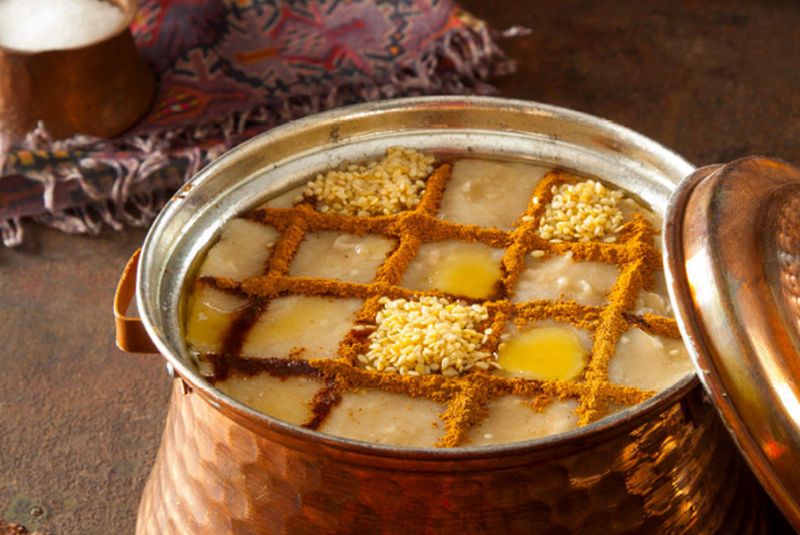
Haleem, a popular Asian dish, takes on a unique character in Iran. Here, it's not just a meal; it's a slow-cooked symphony of flavors and textures, perfect for starting your day.
The heart of Iranian Haleem lies in the harmonious blend of wheat and meat (lamb, turkey, or even beef). This hearty combination undergoes a lengthy cooking process, allowing the meat to reach melt-in-your-mouth tenderness. The slow simmering not only ensures perfect texture but also allows the flavors to meld seamlessly.
While the base of Haleem is undeniably savory, Iranian tradition adds a touch of sweet indulgence. The dish is often served with a dollop of butter, a sprinkle of cinnamon powder, and a touch of sugar. This unexpected sweetness creates a delightful textural and flavor contrast, making Haleem a truly memorable breakfast experience.
Haleem isn't just delicious; it's also incredibly nutritious. The combination of wheat and meat provides sustained energy, keeping you full and focused throughout your morning.
| Suggestion: Top Iran's Fruits
12- Gharegurut
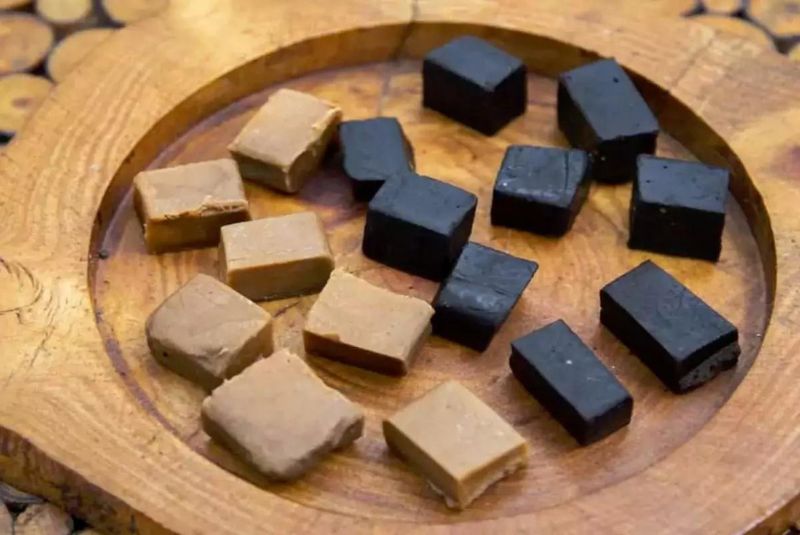
Gharegurut, also known as Black Kashk, is a unique Iranian dairy product that embodies the essence of Kashk. Kashk itself is a fermented whey byproduct created during cheesemaking. Not only as a healthy snack, it’s a staple ingredient in Iranian cuisine (Kashk-e Bademjan), adding a depth of umami flavor to various dishes.
Kashk comes in a variety of forms, ranging from light-colored and mild to the intense and dark Gharegurut. This color variation reflects the drying process. White Kashk is simply air-dried, while Black Kashk undergoes a longer process, often involving heat and smoking, resulting in its signature dark color and potent flavor.
Don't let its unassuming appearance fool you! Gharegurut packs a powerful punch of flavor. It's incredibly sour and salty, with a complex umami depth. This intensity is why it's typically enjoyed in small quantities, either as a snack on its own or as a condiment.
Gharegurut's powerful flavor profile makes it a versatile condiment. It adds a unique dimension to soups, stews, and dips. A small dollop can elevate the complexity of Ash (Iranian noodle soup) or add a delightful tang to lentil stews.
Final Takeaway
From the surprising sweetness of Khoresht-e Mast to the bold flavors of Kalle Pache, Iranian cuisine offers a world of unexpected delights.
This exploration of Unusual Foods in Iran has only scratched the surface of this rich culinary tradition.
So, pack your sense of adventure and prepare to be surprised by the delicious diversity Iran has to offer.
Share your story!
Comment below and let us know about your Experience.
Your story inspires others!


Comment
Leave a Comment